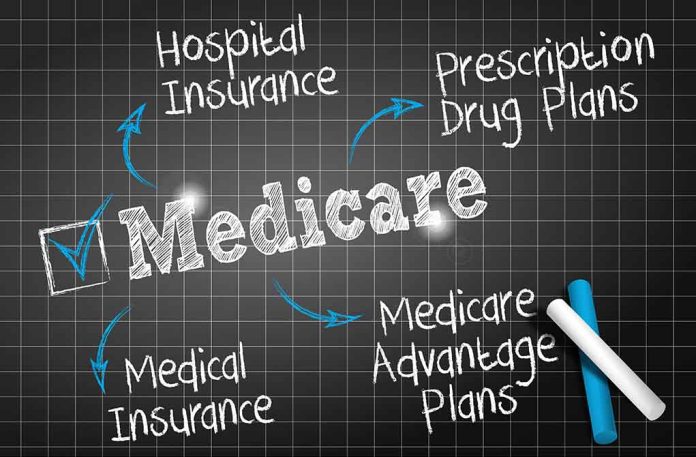
(RepublicanView.org) – Medicare insurance consists of three basic parts for most people. Part A covers hospitalization, skilled nursing facility care, hospice care, and home health care. Part B covers medically necessary services and preventive services, and Part D covers prescriptions and medications.
Typically, people 65 years old and older or those who are younger but disabled don’t have to pay a premium for Part A but must still pay premiums for Parts B and D. However, some people choose to replace Part A with Part C, a PPO or HMO-type plan that often includes coverage for Parts B and D for a single premium.
Each person’s premiums for parts B and D vary based on what they paid into Medicare insurance throughout their working years and their coverage level. Medicare coverage is often less expensive than private health plans. Still, premiums, copays, and deductibles can add up, placing a financial strain on elderly or disabled citizens with fixed incomes.
To help reduce or even eliminate certain Medicare insurance costs, the government offers four Medicare Savings Programs. Let’s review these programs and some of the qualifications to enroll.
Qualified Disabled and Working Individuals (QDWI) Program
This program helps pay part A premiums for those over age 65 with a disability, who are working, or who lost their Social Security Disability (SSD) benefits and free Part A premiums because they returned to work. As of 2022, the income and resource limits for the QDWI program are:
- $4,615 individual monthly income and $6,189 married couple monthly income
- $4,000 individual resource limit and $6,000 married couple resource limit
To qualify for the QDWI program, you cannot receive medical benefits from the state where you live.
Qualifying Individual (QI) Program
The QI program helps people pay for their Part B premiums if they also have Medicare Part A. Individuals must apply for QI benefits annually and prove they have limited income and resources. The program awards benefits on a first-come, first-served basis and prioritizes people who received QI benefits in previous years. As of 2022, the income and resource limits for the QI program are:
- $1,549 individual monthly income and $2,080 married couple monthly income
- $8,400 individual resource limit and $12,600 married couple resource limit
If an individual qualifies for Medicaid, they won’t qualify for QI program benefits.
Specified Low-Income Medicare Beneficiary Program (SLMB)
This program helps qualified individuals pay for Medicare Part B premiums, covering certain types of doctors’ services, outpatient care, some medical supplies, and preventive services. The SLMB program has required income and resource limits for 2022 as follows:
- $1,379 individual monthly income and $1,851 married couple monthly income
- $8,400 individual resource limit and $12,600 married couple resource limit
Limits in Alaska and Hawaii are slightly higher for the SLMB program. The limits between the SLMB and QI programs are the primary difference between the two.
Qualified Medicare Beneficiary (QMB) Program
The Qualified Medicare Beneficiary (QMB) Program assists people in paying for Parts B and D premiums, deductibles, coinsurance, and copayments for covered items and services. The QMB program has strict income and resource limits for individuals and married couples. These limits change annually. Currently, they are:
- $1,153 individual monthly income and $1,546 married couple monthly income
- $8,400 individual resource limit and $12,600 married couple resource limit
The limits are typically slightly higher in Alaska and Hawaii. People living in either place with incomes and resources only slightly over the limit should apply. People might still qualify for the QMB program and would probably qualify for one of the other programs.
Vendors and providers cannot bill those who qualify for the QMB program for services and items except outpatient prescription drugs. In 2022, pharmacists cannot charge QMB patients more than $4.00 for any drug covered under Medicare Part D. In some states, Medicaid pays some of the out-of-pocket cost-sharing expenses of the QMB program because recipients fall below the poverty line for income.
People who qualify for Medicare insurance but have limited resources and income might find relief through one of these four programs. To find out more, visit the Medicare website and select your state to begin the application process. Alternatively, anyone who finds themselves hospitalized should ask their social worker or case manager for assistance in finding help with Medicare saving programs.
Copyright 2023, RepublicanView.org

















